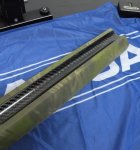Looking to bed or have a smith bed my Remington 700, sitting in a Mcmillian A5. It seems there are more than just one method to do this. Iv read anything from, bedding just the chamber, chamber and forward of the recoil lug and pressure bedding the barrel. What in your opinion is the best method, as far as accuracy is concerned? Thanks
Join the Hide community
Get access to live stream, lessons, the post exchange, and chat with other snipers.
Register
Download Gravity Ballistics
Get help to accurately calculate and scope your sniper rifle using real shooting data.

Install the app
How to install the app on iOS
Follow along with the video below to see how to install our site as a web app on your home screen.
Note: This feature may not be available in some browsers.
You are using an out of date browser. It may not display this or other websites correctly.
You should upgrade or use an alternative browser.
You should upgrade or use an alternative browser.
What bedding method do you use for best accuracy
- Thread starter G101489
- Start date
Is the rifle having accuracy issues?
I've bedded 700 pattern actions on HS Precision and McMillan stocks using a thin layer of Marine Tex and plenty of mold release/shoe polish.
back of the lug face to back of the action. Take your time and plan this out...it really can use very minimal MarineTex and, if done correctly, can result in a hell of a lot less clean-up.
I've bedded 700 pattern actions on HS Precision and McMillan stocks using a thin layer of Marine Tex and plenty of mold release/shoe polish.
back of the lug face to back of the action. Take your time and plan this out...it really can use very minimal MarineTex and, if done correctly, can result in a hell of a lot less clean-up.
I've used this method several times and it just plain works.
http://www.varminthunters.com/tech/pillarbedding.html
http://www.varminthunters.com/tech/pillarbedding.html
It depends on the barrel, but it is very unlikely that you want to bed the barrel. It's easy to do a shitty bedding job. Just remember the purpose is to provide a stress-free mating of the action to the stock, guarantee repeatability, and stay out of the way, all at the same time. A lot of times a bad bedding job is worse than no bedding at all.
I have had reputable smith's (RW Snyder, Alex Sitman, etc) bed my rifles and let them worry about how.
I bed from the recoil lug on back. On the recoil lug, the sides, bottom, and front are taped off for clearance. In some stocks, I will bed the first 1.5" of barrel also. This seems to stiffen up some stocks and has given me good results in more than one rifle.
Top is Alex Sitman's (Master Class Stocks) bedding on my 260 R700SA in a McMillan A5. The green/gray in the barrel channel was a sealer that got milled out when the barrel went from Rem Varmint to Hvy Palma.
Bottom is RW Snyder's work on my 300WM R721LA with Crane lug in a Manners T4A. [IMG2=JSON]{"data-align":"none","data-size":"full","src":"https:\/\/farm5.staticflickr.com\/4450\/37000145063_9ef5c2f0e9_b.jpg"}[/IMG2]
Bottom is RW Snyder's work on my 300WM R721LA with Crane lug in a Manners T4A. [IMG2=JSON]{"data-align":"none","data-size":"full","src":"https:\/\/farm5.staticflickr.com\/4450\/37000145063_9ef5c2f0e9_b.jpg"}[/IMG2]
This is good with the standard Remington style flat (or nearly so) lug.On the recoil lug, the sides, bottom, and front are taped off for clearance.
Other lug designs can't be bedded that way necessarily. The Howa recoil lug, for example, needs to be bedded to full contact on the bottom, as the front action screw goes into the lug. If you leave clearance you will induce stress into the action. The Howa lug can be bedded to full contact along the sides and front as well, because the heavily tapered front side prevents mechanical lock if you do so.
I bed from the recoil lug on back. On the recoil lug, the sides, bottom, and front are taped off for clearance. In some stocks, I will bed the first 1.5" of barrel also. This seems to stiffen up some stocks and has given me good results in more than one rifle.
Stiffening up the stock is deff something I want. On my A5, when I load the bipod, I can see the barrel and stock separate from each other. This results is bad groups for me. With the advise from another hide member, I put some automotive cork, about 1 inch in length, under the barrel near the top of the stock. Bipod flex went away and groups improved
How did cork make it stiffer ?
Iay a layer of carbon fiber in the barrel chanel and it will realy stiffen up stocks like McMillan that has no laminate in barrel chanell.-
I apologize, didn't make it stiffer, but it certainly eliminated the flex. It's hard to explain without actually showing. You have a picture of the CF in the bartel
channel ?
Its just two layers of 160-200g carbon fiber (under 6oz/yd2) so under 1mm thick i dont see it as an issue , more work is with sanding and finishing it smoth.,you could cut some corners there, in any case this is all done prior to bedding the action.and CF covers also the action area.
Its just two layers of 160-200g carbon fiber (under 6oz/yd2) so under 1mm thick i dont see it as an issue , more work is with sanding and finishing it smoth.,you could cut some corners there, in any case this is all done prior to bedding the action.and CF covers also the action area.
Where did you get the carbon fiber? That looks really nice
Similar threads
- Replies
- 5
- Views
- 2K
- Replies
- 14
- Views
- 2K
- Replies
- 6
- Views
- 601
- Replies
- 13
- Views
- 733

